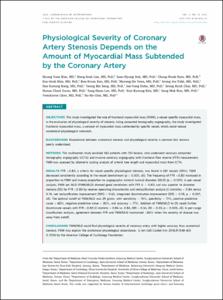KUMEL Repository
1. Journal Papers (연구논문)
1. School of Medicine (의과대학)
Dept. of Internal Medicine (내과학)
Physiological Severity of Coronary Artery Stenosis Depends on the Amount of Myocardial Mass Subtended by the Coronary Artery
- Keimyung Author(s)
- Nam, Chang Wook
- Department
- Dept. of Internal Medicine (내과학)
- Journal Title
- JACC. Cardiovascular Interventions
- Issued Date
- 2016
- Volume
- 9
- Issue
- 15
- Keyword
- anatomical-physiological discordance; coronary artery physiology; fractional flow reserve; fractional myocardial mass
- Abstract
- Objectives:
This study investigated the role of fractional myocardial mass (FMM), a vessel-specific myocardial mass, in the evaluation of physiological severity of stenosis. Using computed tomography angiography, the study investigated fractional myocardial mass, a concept of myocardial mass subtended by specific vessel, which could reduce anatomical-physiological mismatch.
Background:
Discordance between anatomical stenosis and physiological severity is common but remains poorly understood.
Methods:
This multicenter study enrolled 463 patients with 724 lesions, who underwent coronary computed tomography angiography (CCTA) and invasive coronary angiography with fractional flow reserve (FFR) measurement. FMM was assessed by allometric scaling analysis of arterial tree length and myocardial mass from CCTA.
Results:
FFR <0.80, a criteria for vessel-specific physiological stenosis, was found in 281 vessels (39%). FMM decreased consistently according to the vessel downstream (p < 0.001, all). The frequency of FFR <0.80 increased in proportion to FMM and inverse proportion to angiographic minimal luminal diameter (MLD) (p < 0.001). In per-vessel analysis, FMM per MLD (FMM/MLD) showed good correlation with FFR (r = 0.61) and was superior to diameter stenosis (DS) for FFR <0.80 by receiver operating characteristic and reclassification analysis (C-statistics = 0.84 versus 0.74, net reclassification improvement [NRI] = 0.63, integrated discrimination improvement [IDI] = 0.18; p < 0.001, all). The optimal cutoff of FMM/MLD was 29 g/mm, with sensitivity = 75%, specificity = 77%, positive predictive value = 68%, negative predictive value = 83%, and accuracy = 77%. Addition of FMM/MLD to DS could further discriminate vessels with FFR <0.80 (C-statistic = 0.86 vs. 0.84, NRI = 0.34, IDI = 0.03; p < 0.005, all). In per-range classification analysis, agreement between FFR and FMM/MLD maintained >80% when the severity of disease was away from cutoff.
Conclusions:
FMM/MLD could find physiological severity of coronary artery with higher accuracy than anatomical stenosis. FMM may explain the anatomical-physiological discordance.
- Keimyung Author(s)(Kor)
- 남창욱
- Publisher
- School of Medicine
- Citation
- Doo Kyoung Kang et al. (2016). Physiological Severity of Coronary Artery Stenosis Depends on the Amount of Myocardial Mass Subtended by the Coronary Artery. JACC. Cardiovascular Interventions, 9(15), 1548–1560. doi: 10.1016/j.jcin.2016.04.008
- Type
- Article
- ISSN
- 1936-8798
- Appears in Collections:
- 1. School of Medicine (의과대학) > Dept. of Internal Medicine (내과학)
- 파일 목록
-
-
Download
 oak-2017-0183.pdf
기타 데이터 / 3.04 MB / Adobe PDF
oak-2017-0183.pdf
기타 데이터 / 3.04 MB / Adobe PDF
-
Items in Repository are protected by copyright, with all rights reserved, unless otherwise indicated.